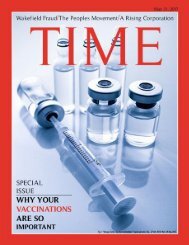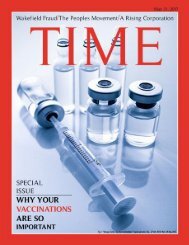JEP mag
Create successful ePaper yourself
Turn your PDF publications into a flip-book with our unique Google optimized e-Paper software.
Thimerosal: A Safe Preservative<br />
Avariety of studies have been conducted<br />
that looked at the different<br />
effects thimerosal had, or were<br />
thought to have had on the body. A look<br />
at 9 of such studies ranging from early<br />
life exposure to thimerosal to ten years<br />
later. The first study looked at the effect<br />
that thimerosal exposure in early life had<br />
on brain functions, language, behavior,<br />
and coordination. It also looked at the<br />
nueropsychological outcomes 7 to 10<br />
years later, and it found that there were<br />
no associations with thimerosal and the<br />
general intellectual functioning, verbal<br />
memory, executive functioning, behavior<br />
regulation, fine motor coordination,<br />
and language in the children that were<br />
exposed to thimerosal. They did however,<br />
find that there was a small association<br />
between the thimerosal exposure and<br />
tics in boys. A second study looked at thimerosal<br />
exposure within the womb and<br />
in infancy. It compared children with and<br />
without autism, and looked at the exposure<br />
that they had to thimerosal from vaccines<br />
in infancy. It found that there was<br />
no difference in the exposure to thimerosal<br />
between the children that had autism<br />
and those that did not have autism. A<br />
third study, which was funded by the Center<br />
for Disease Control and Prevention,<br />
looked at the long term effect of thimerosal<br />
exposure, which compared the neuropsychological<br />
outcomes of the children<br />
they randomly selected to receive a form<br />
of diphtheria-tetanus-acellular pertussive<br />
vaccine, or DTaP for short, within the first<br />
year of life. One of these contained thimerosal<br />
and the other did not, and ten<br />
years later they were tested for 24 neuropsychocological<br />
outcomes, and the results<br />
did not show that thimerosal in vaccines<br />
were harmful to children. A fourth<br />
study looked at thimerosal in vaccines in<br />
the United States, the United Kingdom,<br />
and Denmark. This was an analysis of<br />
data from “ the US health maintenace<br />
orgainzations, the UK General Practice<br />
Research Database, and the entire country<br />
of Denmark” ( CDC para 4). They all<br />
also failed to find a link between thimerosal<br />
in vaccines and causing autism. A fifth<br />
study looked at thimerosal within childrens<br />
flu shots. This study “measured the<br />
proportion of injection site reactions and<br />
the infections that were reported to the<br />
Vaccine Adverse Event Reporting System<br />
after testing three versions of an inactivated<br />
influenza vaccine in children that<br />
were under the age of 2” (CDC para 5).<br />
The three versions that they tested, which<br />
had thimerosal present within them and<br />
ones which did not contain any thimerosal,<br />
found that there was no difference<br />
between the proportion of ISR, rash or<br />
infections. A sixth study looked at whether<br />
or not thimerosal caused neurodevelopmental<br />
disorders with in children. This<br />
study only found “a few statistically significant<br />
associations between exposer<br />
from thimerosal and nueropsychological<br />
functioning” (CDC 6). The results showed<br />
no link between neurodevelopmental disorders<br />
within children and vaccinations<br />
that contained thimerosal.<br />
May 31, 2017 TIME 7





